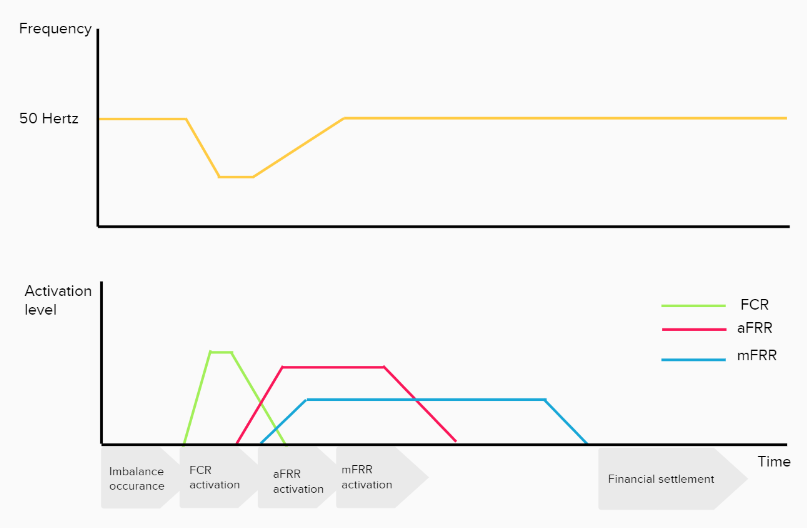The energy sector is developing rapidly. The process of European market integration began some years ago. Its purpose is to create a single European market that enables market parties to trade gas and electricity across national borders easily and efficiently.
Electricity market

Transparency data
We provide transparency data on our operations on our Dutch and German transparency page and on ENTSO-E.
To transparency pagesE-Insights
Our vision is to be one of the most transparent Transmission System Operators (TSO) in Europe and thereby creating value for society. In this Energy Insights section we present selected energy related topics and show data, information and valuable insights.

For more detailed information on the roles please refer to our market roles page.
Transmission system operators
TSOs have the final responsibility for maintaining the grid frequency of 50 Hertz at all times. In the Netherlands the TSO is TenneT. If an imbalance occurs in the Netherlands TenneT sends a signal to the balance service providers (BSP) who then activate balancing energy to reinstate the system balance. For that, we have multiple balancing products at hand which are explained in more detail here -> Dutch Ancillary Services - TenneT. In contrast to (some) other TSOs, TenneT’s balancing approach is of a reactive nature. This means we only activate balancing products if imbalances actually occur, not in response to forecasted imbalances.
TSO’s (should) not take sides in the electricity market and therefore is not allowed to own any generation or demand assets (exception for their buildings, that need to be supplied with power). In order to coordinate the balancing process TenneT needs to ensure a sufficient amount of balancing capacity. This is organized through the BSP market role. (Link to Onboarding page- the one that is still being created by Marjan and Marieke). BSPs have to prequalify one or multiple assets or a pool of aggregated smaller assets in order to prove their ability to meet the technical requirements for the different balancing products. These BSP can offer their capacity for these different balancing products. These are the markets for Balancing Capacity.
Balance Reponsible Parties
To avoid such imbalances as much as possible, each supplier or buyer with a connection to the grid carries balance responsibility and needs to be connected to a Balance Responsible Party (BRP). A BRP is financially responsible for any imbalances that occur in his/her portfolio of grid allocation points. BRPs have the opportunity to correct their own imbalance before the imbalance settlement period (ISP) ends (15min), without facing financial consequences. They can do that for example by changing load or production behind their allocation points or making a trade with another BRP.
At the same time, TenneT publishes the real-time imbalance prices. With this information BRPs can decide themselves to increase their imbalance if it helps the overall system balance and makes financial sense for them. This is called passive balancing. TenneT settles the BRP for the imbalance according to the imbalance price. If the BRP contributed to an imbalance of the system, the BRP will have to pay TenneT. If the imbalance of the BRP supported the system, the BRP will receive the imbalance price from TenneT.
Procurement of balancing capacity
As electricity supply and demand need to be in balance at all times, TenneT procures balancing reserves that differ in terms of minimum bid sizes, activation, duration and ramp rates. There are three main products for balancing:
1. Frequency Containment Reserves (FCR). To fulfil its international balancing obligation, TenneT procures a certain amount of Frequency Containment Reserves (FCR) that is determined by EU regulation. (Link to Dutch ancillary services page). FCR is activated automatically based on the frequency instead of by the TSO.
2. There are two main balancing products in the Netherlands: automatic Frequency Restoration Reserve (aFRR) and manual Frequency Restoration Reserves (mFRR). Every half year we calculate the amount of balancing reserves needed and procure this capacity in a daily auction. (Link to documentation about dimensioning).
a. aFRR is procured through so called “bid-obligations”. That means BSPs are contracted to provide balancing energy bids to TenneT at certain times. Non-contracted BSPs can also submit so called “free-bids”, which compete on the same merit order list with contracted-bids. This ensures that there are always sufficient balancing bids available, while the price for them continues to be determined by the market. (Also see section “Formation of the price” below).
b. For mFRR, there are no bid-obligation contracts but capacity contracts. Market participants need to have this capacity available at all times and when needed, TenneT activates the procured amount without making use of a merit order list.
Each of these products has different technical requirements which can be found here.
Activation of balancing energy
If an imbalance occurs in the synchronous grid of continental Europe the frequency drops below or exceeds the standard of 50 Hertz. BSPs continuously monitor the frequency. If it deviates from 50Hz, FCR is activated within seconds to stabilize the frequency. FCR works across borders and for the entire synchronous grid of continental Europe. In parallel, the TSO of the area where the imbalance occurs automatically requests the BSPs to activate automatic Frequency Restoration Reserves (aFRR). Sometimes, aFRR activation can be avoided through imbalance netting via International Grid Control Cooperation (IGCC). With IGCC European TSOs avoids simultaneous aFRR activation in opposite direction in neighboring grid zones. The extent to which IGCC can be used however depends on the available cross-border capacity. In case of a longer system imbalance or large imbalances, TenneT can activate manual Frequency Restoration Reserves (mFRR). As its name suggests, mFRR is not automatically activated by the algorithm but manually by a person in the control room.

Price formation
To determine the price of balancing energy per ISP, TenneT compiles an aFRR merit order list of all aFRR energy bids (contracted and free). The balancing energy price is based on the highest activated FRR bid. This is the price that the BSPs receive. In some instances BSPs also offer to pay TenneT, for example if power for downward regulation is delivered with resources that have fuel costs. The imbalance price is (most of the time) equal to the balancing energy price. It is used to financially settle BRPs for deviating from their portfolio forecasts.
The imbalance price is what BRPs need to pay TenneT for having imbalances that contribute to the total system imbalance. When BRPs in turn help resolving the system balance, they receive the imbalance price from TenneT. Passive balancing, as it is called is possible because BRPs have access to live updates on balancing energy activation volumes and prices on our website. This way TenneT financially stimulates BRPs to deviate from their portfolio if this reduces the overall system imbalance. That means BRPs may also purposely incur an imbalance in their own portfolio if its adverse to total system imbalance and they receive the imbalance price for it.
When no balancing energy is activated in an ISP (happens more often since there is imbalance netting) the settlement price for BRPs imbalances is determined with the mid-price. The mid-price is the average of the first upward bid and first downward bid on the common merit order list. For more detailed information refer to the documentation on imbalance pricing.
